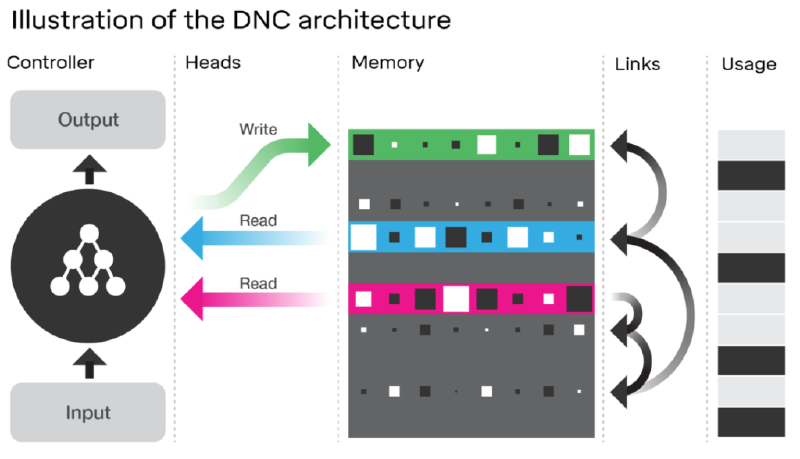Pure NumPy based implementation of Differentiable Neural Computer (DNC), intending to be read for understanding the architecture. In comparison to well developed deep learning frameworks, one of the advantages of reading through NumPy implementation is the explicit details of vectorizing computations to speed up training and inferencing. Operations are broken down according to corresponding subsections in the paper.
The code is currently structured as follows:
accessor.pyimplements the writing and reading interactions with memory based on the emitted interface vector from the controller, as detailed in the METHODS section of the paper.dnc_lstm.pyimplements a DNC model with single layer LSTM controller.dnc_ff.pyimplements a DNC model with a feedforward controller.util.pyincludes a variety of helper functions.unit_test.pyprovides test cases to check against the correctness of each operation and the corresponding gradient.CopyTask.ipynbintends to provide an example trainer for DNC with visualization of results on the copy task.RepeatedCopyTask.ipynbprovides visualization of results on the repeated copy task.
The directory structure may subject to change. The code is Python 2.7.
The project relies on the NumPy based autograd library (pip install autograd) for automatic differentiation during backprop. In near future, I want to remove this dependency by building my own automatic differentiation DAG constructor.
DNC belongs to the family of memory-augmented neural networks, which are designed to be able to represent variables and data structures. Results from the paper have shown the potential for DNC to solve complex and structured tasks that are difficult for neural networks without external memory. The predecessor of DNC is the Neural Turing Machine (NTM). The major difference between the two arise from the difference in access mechanism to interface with the memory matrix:
- NTM has no way to prevent overlapping or interference among allocated memory locations. The dynamic memory allocation mechanism allows DNC to avoid this problem.
- NTM cannot free used locations. DNC incorporates the free gates to address this problem.
- NTM can only preserve sequential information in contiguous memory. DNC specifically uses a temporal link matrix to track the order in which the writes were made, effectively decoupling sequential information and memory location.
Currently, the copy and repeated copy tasks are implemented:
In this task, a sequence of bit vectors is provided to the model. The input sequence starts with a reserved start vector, then some random binary bit vectors, followed by a reserved stop vector. The model is expected to start reproducing the exact input bit vectors immediately after observing the stop vector.
Input: The first column of input is the reserved start vector, and the 6th column is the reserved stop vector for input
Target: The last column is the reserved stop vector for output
Output:
Using DNC with LSTM controller: DNC(input_size=seq_wid+2, output_size=seq_wid+1, hidden_size=32, R=2, N=64, W=8) with 30k iterations of training
In this task, a sequence of bit vectors is provided to the model. The input sequence starts with a reserved start vector, then some random binary bit vectors, followed by a reserved count vector, providing the number of intended repetition in a reserved channel. The model is expected to start reproducing the exact input bit vectors for given number of repetitions immediately after observing the count vector.
Input: The first column of input is the reserved start vector, and the 6th column is the reserved count vector for input, with expected number of repetition placed in the count channel (first row). The color shown in the image below is normalized, where the expected number of repetition is 4.
Target: The last column is the reserved stop vector for output
Output:
Using DNC with LSTM controller: DNC(input_size=seq_wid+2, output_size=seq_wid+1, hidden_size=32, R=2, N=64, W=8) with 50k iterations of training
- Complete unit tests and gradient checks for the model.
- Update results on the copy task
- Add checks during training to assess memory usage and allocation
- Expand to batched training and prediction, optimize for training speed
- Implement and benchmark tasks including repeated copy and graph tasks.
- Need to use slicing to implement cumulative product so that gradient can pass through.
- A small number (1e-20) needs to be added to the denominator of cosine similarity calculation to avoid dividing by zero.
- Initial read vector, read weighting, write weighting, and usage vectors are currently initialized to a small number 1e-6. Will test out random initialization, as well as treating the initial values as learnable parameters.
- For content-based addressing with small word size and number of memory locations,
np.einsumprovides faster computation thannp.inner. - The diagonal of temporal linkage matrix should be set to 0 after each update.
- For allocation weighting, the order of calculation is based on usage vector with permutated index list using
np.argsort. We thus need to apply inverse permutation before returning the resulting allocation weighting. To obtain the inverse permutation, we just need to applynp.argsortto the permutated index list. - Calculation of usage is not differentiable with respect to write weights. May need to stop gradient to pass through write weights during backprop. Or alternatively, detach memory at each time step.
- Be careful when using the numerical gradient check in
unit_test.py, multiple calls to a function may change its internal state multiple time in comparison to one pass with autodiff (i.e.self.states.append(dict(zip(['u', 'ww', 'p', 'L', 'rw'],[u, ww, p, L, rw])))inaccessor.pybreaks numerical gradient, must reinitialize accessor before each function evaluation inunit_test.py. - For the copy and repeated copy tasks, according to DeepMind's official implementation, the output emitted by the DNC when it is receiving input should not be penalized; only output after receiving the reserved stop vector is used for loss calculation. However, I penalized random output emission when DNC is reading input. It turns out that the DNC controller is able to learn to suppress its output when it is receiving input.






